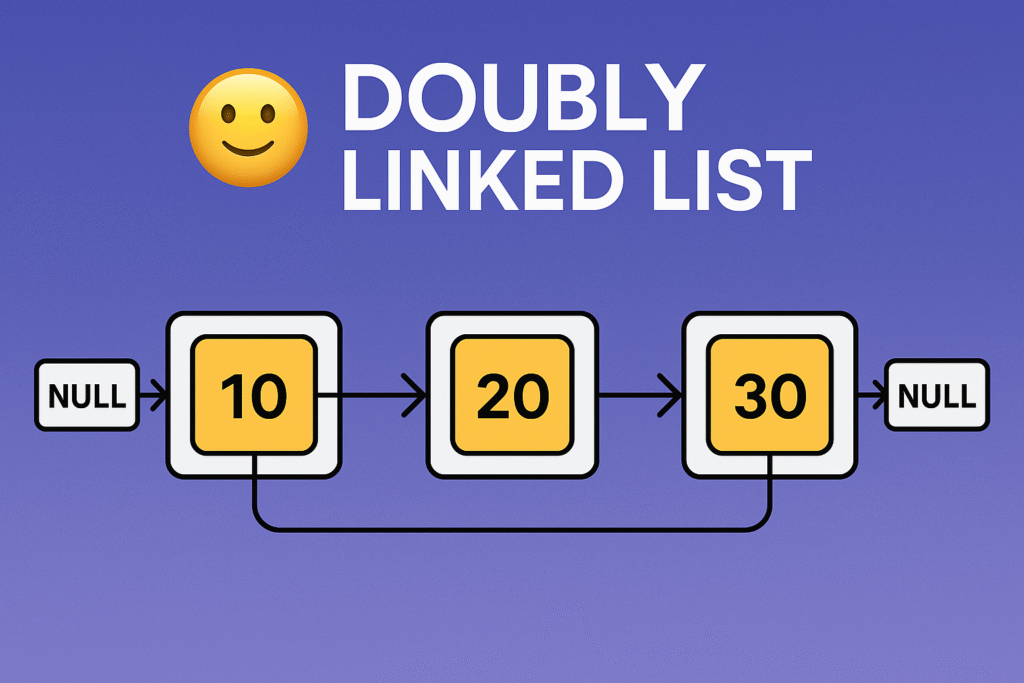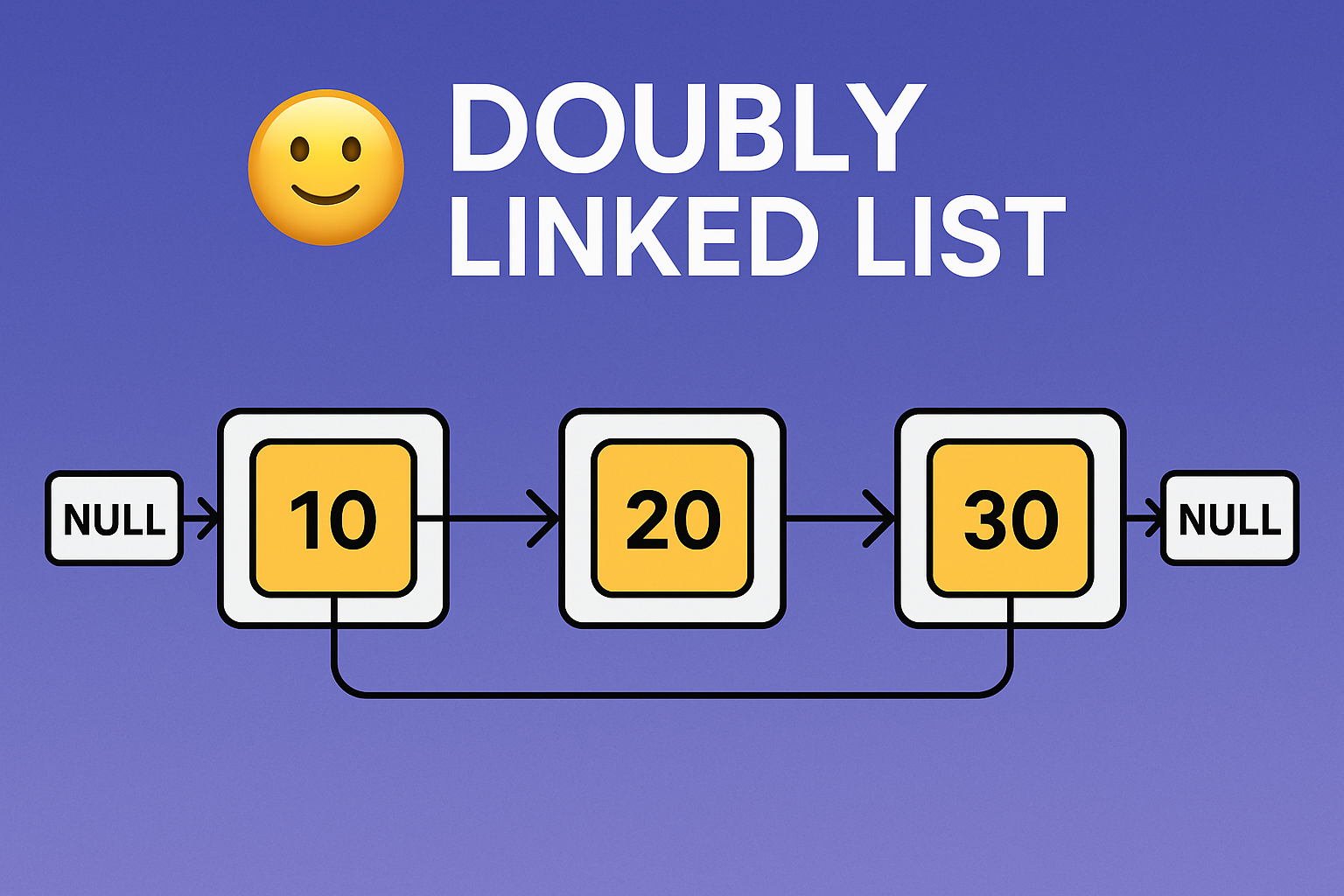Introduction to Doubly Linked List
When you’re learning data structures, you’ll often hear about Linked Lists. A Doubly Linked List (DLL) is a powerful and flexible variation of the basic Singly Linked List that allows you to traverse in both directions — forward and backward.
In this beginner-friendly article, we’ll explore:
- What is a Doubly Linked List?
- How it works (with diagrams)
- Real-world uses
- Advantages over singly linked list
- Basic operations (insertion, deletion, traversal)
- Code example in C/C++
🚀 Whether you’re preparing for coding interviews or improving your DSA skills, understanding doubly linked lists is a must!
What is a Doubly Linked List?
A Doubly Linked List is a type of linear data structure made up of nodes, where each node contains:
- Data (the actual value)
- Pointer to the next node
- Pointer to the previous node
⚙️ Node Structure of Doubly Linked List:
+-------+----------+----------+
| prev | data | next |
+-------+----------+----------+
Each node is connected to its previous and next node, unlike a singly linked list, which only has a next pointer.
Visual Representation of Doubly Linked List
Let’s say we have 3 nodes with data: 10, 20, and 30.
NULL <- [10] <-> [20] <-> [30] -> NULL
Here:
- Node 10’s
previs NULL - Node 20’s
prevpoints to 10 andnextto 30 - Node 30’s
nextis NULL
Basic Operations on Doubly Linked List
1. Insertion
- At the beginning
- At the end
- At a specific position
2. Deletion
- From the beginning
- From the end
- Specific node
3. Traversal
- Forward traversal (left to right)
- Backward traversal (right to left)
C Code Example: Basic DLL Operations
#include <stdio.h>
#include <stdlib.h>
typedef struct Node {
int data;
struct Node* prev;
struct Node* next;
} Node;
Node* head = NULL;
// Insert at end
void insertEnd(int value) {
Node* newNode = (Node*)malloc(sizeof(Node));
newNode->data = value;
newNode->next = NULL;
if (head == NULL) {
newNode->prev = NULL;
head = newNode;
return;
}
Node* temp = head;
while (temp->next != NULL)
temp = temp->next;
temp->next = newNode;
newNode->prev = temp;
}
// Display forward
void displayForward() {
Node* temp = head;
printf("DLL (forward): ");
while (temp != NULL) {
printf("%d <-> ", temp->data);
temp = temp->next;
}
printf("NULL\n");
}
// Display backward
void displayBackward() {
Node* temp = head;
if (!temp) return;
// Go to last node
while (temp->next != NULL)
temp = temp->next;
printf("DLL (backward): ");
while (temp != NULL) {
printf("%d <-> ", temp->data);
temp = temp->prev;
}
printf("NULL\n");
}
int main() {
insertEnd(10);
insertEnd(20);
insertEnd(30);
displayForward();
displayBackward();
return 0;
}
Advantages of Doubly Linked List
- Two-way traversal: You can navigate forward and backward.
- Easier deletion: You can delete a node without needing the previous node pointer.
- More flexible: Especially useful in complex data structures like Deques, Undo/Redo systems, Music Playlists, etc.
Disadvantages of Doubly Linked List
- More memory: Each node requires extra space for the
prevpointer. - More complex: Handling pointers can be error-prone for beginners.
Real-Life Applications of Doubly Linked List
- Web browsers (backward and forward navigation)
- Music playlist apps
- Text editors (undo/redo operations)
- Task managers (circular doubly linked lists for round-robin)
Conclusion DLL

The Doubly Linked List is an essential topic in Data Structures and Algorithms (DSA). It offers a better way to manage dynamic data, especially when two-way traversal is needed. Though slightly more complex than a singly linked list, the benefits are powerful.
Whether you’re preparing for a coding interview, building a system-level application, or just learning C programming, mastering DLLs will give you a strong foundation in memory management and pointer logic.
FAQs of Doubly Linked List
Q1: Is doubly linked list faster than singly linked list?
Ans: DLL allows backward traversal and easier deletion, but it uses more memory. It’s more flexible, not necessarily faster.
Q2: Where is DLL used in real life?
Ans: Browser history, playlist navigation, undo/redo features, and memory management systems.
Q3: What is the main drawback of doubly linked list?
Ans: It uses extra memory due to the additional prev pointer and increases code complexity.
Q4: How is a doubly linked list different from a circular doubly linked list?
Ans: In a doubly linked list, the last node’s next pointer is NULL, whereas in a circular doubly linked list, the last node’s next points back to the head, forming a circle.
Q5: Can a doubly linked list be empty?
Ans: Yes, initially a doubly linked list can be empty with head pointing to NULL.
Q6: How do you insert a node at the beginning of a doubly linked list?
Ans: Create a new node, point its next to the current head, set the head’s prev to the new node, and then update head to the new node.
Q7: What happens when you delete the last node in a doubly linked list?
Ans: The second last node’s next pointer is set to NULL, and the last node is freed from memory.
Q8: Is it possible to implement a stack using a doubly linked list?
Ans: Yes, a doubly linked list can be used to implement a stack with push and pop operations.
Q9: How does traversal in a doubly linked list work?
Ans: You can traverse forward from head to NULL using next pointers or backward from the last node to head using prev pointers.
Q10: What are the memory requirements for a doubly linked list node?
Ans: Each node stores data plus two pointers (prev and next), so it uses more memory compared to a singly linked list node, which stores only one pointer.
Q11: Can doubly linked lists have cycles? How to detect them?
Ans: Yes, cycles can exist if nodes point back to earlier nodes. Cycle detection algorithms like Floyd’s Cycle-Finding Algorithm (tortoise and hare) can detect cycles.
Q12: Are doubly linked lists used in databases?
Ans: Yes, doubly linked lists are used to implement certain data structures like LRU caches, which are common in databases and operating systems.
Q13: How do you reverse a doubly linked list?
Ans: Swap the prev and next pointers for each node and update the head to the last node.
You can also Visit other tutorials of Embedded Prep
- Linked List Explained: Master Complete Guide for Beginners 2025
- Master Doubly Linked List in Data Structures (With Examples) 2025
- Multithreading in C++
- Multithreading Interview Questions
- Multithreading in Operating System
- Multithreading in Java
- POSIX Threads pthread Beginner’s Guide in C/C++
- Speed Up Code using Multithreading
- Limitations of Multithreading
- Common Issues in Multithreading
- Multithreading Program with One Thread for Addition and One for Multiplication
- Advantage of Multithreading
- Disadvantages of Multithreading
- Applications of Multithreading: How Multithreading Makes Modern Software Faster and Smarter”
Mr. Raj Kumar is a highly experienced Technical Content Engineer with 7 years of dedicated expertise in the intricate field of embedded systems. At Embedded Prep, Raj is at the forefront of creating and curating high-quality technical content designed to educate and empower aspiring and seasoned professionals in the embedded domain.
Throughout his career, Raj has honed a unique skill set that bridges the gap between deep technical understanding and effective communication. His work encompasses a wide range of educational materials, including in-depth tutorials, practical guides, course modules, and insightful articles focused on embedded hardware and software solutions. He possesses a strong grasp of embedded architectures, microcontrollers, real-time operating systems (RTOS), firmware development, and various communication protocols relevant to the embedded industry.
Raj is adept at collaborating closely with subject matter experts, engineers, and instructional designers to ensure the accuracy, completeness, and pedagogical effectiveness of the content. His meticulous attention to detail and commitment to clarity are instrumental in transforming complex embedded concepts into easily digestible and engaging learning experiences. At Embedded Prep, he plays a crucial role in building a robust knowledge base that helps learners master the complexities of embedded technologies.



Leave a Reply